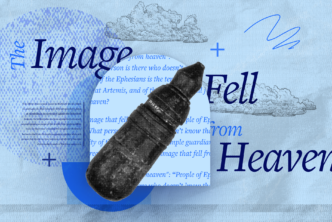Our English translations differ for two basic reasons: (1) underlying text and (2) translation philosophy. I’ll start with the latter. “Formal” (sometimes called literal) translations tend to retain the forms of the original languages even when that makes understanding a bit more difficult; “functional” (sometimes called dynamic) translations tend to yield more often to the conventions of modern language.
Differences in translation philosophy are understood by many Bible students. But differences between English Bibles that are caused by the underlying text are, by their nature, less well understood because they require knowledge of Hebrew and Greek. The following examples demonstrate why contemporary English translations differ from older ones in a few places and why in a few others even modern translations are split over how to use the text of the Dead Sea Scrolls.
1. “Three Bulls” or “Three-Year-Old Bull”? (1 Sam 1:24)
Did Elkanah and Hannah bring one three-year-old bull or three bulls to sacrifice at Shiloh? Dependent on the medieval Hebrew manuscripts, the King James Version reads,
And when she had weaned him, she took him up with her, with three bullocks.
But the English Standard Version translators went with a reading found in the Septuagint and one of the DSS (4QSama):
And when she had weaned him, she took him up with her, along with a three-year-old bull.
The New International Version (NIV) reads similarly to the ESV in this case, and both translations leave a footnote providing the evidence for each reading. Researchers are convinced that the reading in the medieval manuscripts arose due to a copyist’s error.
2. A missing verse is found (Ps 145:13–14)
Psalm 145 is an acrostic psalm: each verse begins with the successive letter of the Hebrew alphabet. But between verses 13–14 the line that should begin with N (Hebrew nun) is lacking in the Masoretic Text. Thus, instead of KLMNS (etc.), the KJV skips the “N” (KLMS):
(M) Thy kingdom is an everlasting kingdom, and thy dominion endureth throughout all generations.
(S) The Lord upholdeth all that fall, and raiseth up all those that be bowed down.
But the Septuagint had a longer text that some researchers thought probably went back to an earlier Hebrew text. And when the Great Psalms Scroll (called 11QPsa) was discovered in 1956, for the first time researchers could confirm that there was an early Hebrew manuscript that contained the missing verse. Most researchers believe that the line was probably omitted accidentally in the Masoretic tradition and thus think that the Septuagint and 11QPsa preserve the original text. Thus, the niv’s text reflects an addition at the end of verse 13:
(M) Your kingdom is an everlasting kingdom, and your dominion endures through all generations.
(N) The Lord is trustworthy in all he promises and faithful in all he does.
(S) The Lord upholds all who fall and lifts up all who are bowed down.
The ESV has a similar translation and currently places the additional text in brackets with a footnote explaining the situation.
3. Who is exhorted to rejoice and worship? (Deut 32:43)
English translations answer this question differently because they translate different texts. The KJV and the NIV say something like, “Rejoice, you nations, with his people.” But the ESV contains a longer, different translation: “Rejoice with him, O heavens; bow down to him, all gods.” Again, these readings have not been invented whole cloth. Rather, the KJV has stuck with the Masoretic Text, while the ESV has gone with one of the DSS known as 4QDeutq.
Interestingly, the ancient Septuagint actually combined these two texts. Deciding between the two texts is difficult, but many scholars favor the reading in the scroll as the original text, because they believe that a later scribe would be more likely to omit the reference to “all gods” than to add it. Thus, it is the more difficult reading, the one that best explains the existence of the shorter and less theologically controversial reading in the later Hebrew manuscripts.
Conclusion
We have been able to give only a flyover of a few examples, but already we can tell that the Dead Sea Scrolls have influenced our English Bibles in great ways. Over the past 75 years since their discovery, researchers continue to read them and ask what they tell us about the state of the Scriptures in that time. Do the scrolls preserve an older wording than the later Hebrew manuscripts? The matter is not as simple as choosing the readings found in the older scrolls.
Rather, over the next 75 years English Bible translators await new research into the scrolls and the other sources so they can continue to conform their translations to the oldest retrievable wording; for there we find the inspired text of Scripture.
***
This article was originally published in the January/February 2022 issue of Bible Study Magazine. Slight adjustments, such as title and subheadings, may be the addition of an editor.
Related articles
- The Dead Sea Scrolls: 9 Common Questions, Answered
- What the Dead Sea Scrolls Reveal about the Bible’s Reliability
- 3 Ways the Dead Sea Scrolls Revolutionized NT Studies
Related resources
Mobile Ed: NT306 The Dead Sea Scrolls and the New Testament (5 hour course)
Regular price: $189.99






